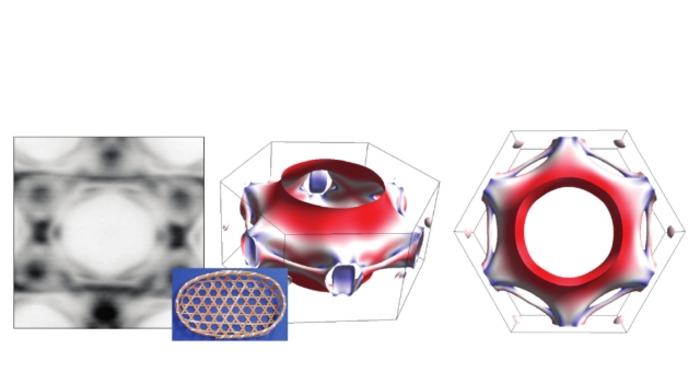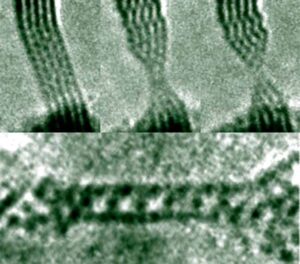
An international team of physicists has succeeded in measuring a property of the electron known as topological spin winding for the first time. The team obtained this result by studying the behaviour of electrons in so-called kagome metals, which are materials that have unique quantum properties related to their physical shape, or topology. The work could advance our understanding of the physics of superconductors and other systems that contain strongly correlated electrons.
Kagome metals are named after a traditional Japanese basket-weaving technique that produces a lattice of interlaced, symmetrical triangles with shared corners. When the atoms of a metal or other conductor are arranged in this kagome pattern, their electrons behave in unusual ways. For example, the wavefunctions of the electrons can interfere destructively, resulting in highly localized electronic states in which the particles interact strongly with each other. These strong interactions lead to a range of quantum phenomena, including magnetic ordering of unpaired electrons spins that can produce, for example, ferro- or antiferromagnetic phases, superconducting structures, quantum spin liquids and abnormal topological phases. All these phases have applications in advanced nanoelectronics and spintronics technologies.
In the new work, researchers led by Domenico Di Sante of the University of Bologna in Italy studied the spin and electronic structure of XV6Sn6, where X is a rare-earth element. These recently-discovered kagome metals contain a Dirac electronic band and a nearly flat electronic band. At the point at which these bands meet, an effect called spin-orbit coupling creates a narrow gap between the bands. This spin-orbit coupling also creates special type of electronic ground state at the material’s surface.
To investigate the nature of this ground state, Di Sante and colleagues used a technique known as spin angle-resolved photoemission spectroscopy (spin ARPES). In this technique, high-energy photons generated by a particle accelerator, or synchrotron, strike the material from different directions, causing it to absorb light and emit electrons. The energy, momenta and spin of these emitted electrons can be measured, and the data used to map the material’s electronic band structure.
Polarized surface electronic states
By combining these measurements with advanced density functional theory (DFT) calculations, the researchers confirmed that the kagome geometry in TbV6Sn6 does indeed give rise to a gap between the Dirac band and the nearly flat band. Such a gap is common to all kagome lattices that show spin-orbit coupling, but while physicists had known about the gap’s existence for years, no one had previously measured a property called topological quantum spin curvature that results from the gap and is related to the curved space in which electrons reside.
“In the same way that the space-time of our universe is curved by matter, stars, galaxies and black holes, the space in which the electrons move can also be curved,” Di Sante explains. “We have detected this curvature in kagome metals.”

Loopy currents appear in a kagome superlattice
The new work represents a first step towards a thorough characterization of this curved space – a key goal in the field of quantum geometry, Di Sante adds. “This is a property of quantum materials that we’ve started exploring only recently and we already know that quantum geometry is also intimately linked to superconductivity and other fascinating phenomena,” he says. “We hope that the protocol we have introduced here will help to shed light on the physics of quantum materials.”
- SEO Powered Content & PR Distribution. Get Amplified Today.
- PlatoData.Network Vertical Generative Ai. Empower Yourself. Access Here.
- PlatoAiStream. Web3 Intelligence. Knowledge Amplified. Access Here.
- PlatoESG. Automotive / EVs, Carbon, CleanTech, Energy, Environment, Solar, Waste Management. Access Here.
- BlockOffsets. Modernizing Environmental Offset Ownership. Access Here.
- Source: https://physicsworld.com/a/physicists-measure-electrons-topological-spin/
- :has
- :is
- :where
- 700
- a
- About
- accelerator
- Adds
- advance
- advanced
- After
- All
- already
- also
- an
- and
- appear
- applications
- ARE
- arranged
- artist
- AS
- At
- BAND
- basket
- BE
- between
- Black
- black holes
- but
- by
- calculations
- called
- CAN
- causing
- click
- colleagues
- COM
- combining
- Common
- CONFIRMED
- contain
- corners
- could
- creates
- data
- detected
- different
- does
- each
- effect
- Electronic
- electrons
- element
- energy
- example
- existence
- Explains
- Exploring
- fascinating
- field
- First
- first time
- flat
- For
- from
- functional
- Galaxies
- gap
- generated
- Give
- goal
- Ground
- had
- Have
- he
- help
- here
- highly
- Holes
- hope
- HTTPS
- image
- in
- Including
- indeed
- information
- interact
- interactions
- interfere
- International
- introduced
- investigate
- issue
- IT
- Japanese
- jpg
- Key
- Know
- known
- lead
- Led
- light
- linked
- map
- material
- materials
- Matter
- max-width
- measure
- measurements
- measuring
- Meet
- metal
- Metals
- move
- Named
- narrow
- Nature
- nearly
- New
- no
- obtained
- of
- on
- ONE
- only
- open
- or
- Other
- our
- Pattern
- perspectives
- photo
- Photons
- physical
- Physics
- Physics World
- plato
- Plato Data Intelligence
- PlatoData
- Point
- previously
- produce
- produces
- properties
- property
- protocol
- Quantum
- range
- recently
- related
- represents
- researchers
- result
- resulting
- Results
- Rise
- s
- same
- says
- Shape
- shared
- shed
- show
- Shows
- Space
- special
- Spectroscopy
- Spin
- spins
- Stars
- started
- State
- States
- Step
- strike
- strong
- strongly
- structure
- studied
- Studying
- such
- superconducting
- Superconductivity
- Surface
- Systems
- team
- Technologies
- that
- The
- their
- theory
- These
- this
- three
- thumbnail
- time
- to
- topological quantum
- towards
- traditional
- true
- type
- understanding
- unique
- Universe
- university
- used
- Way..
- ways
- we
- Weave
- when
- which
- while
- will
- with
- Work
- world
- X
- years
- zephyrnet













